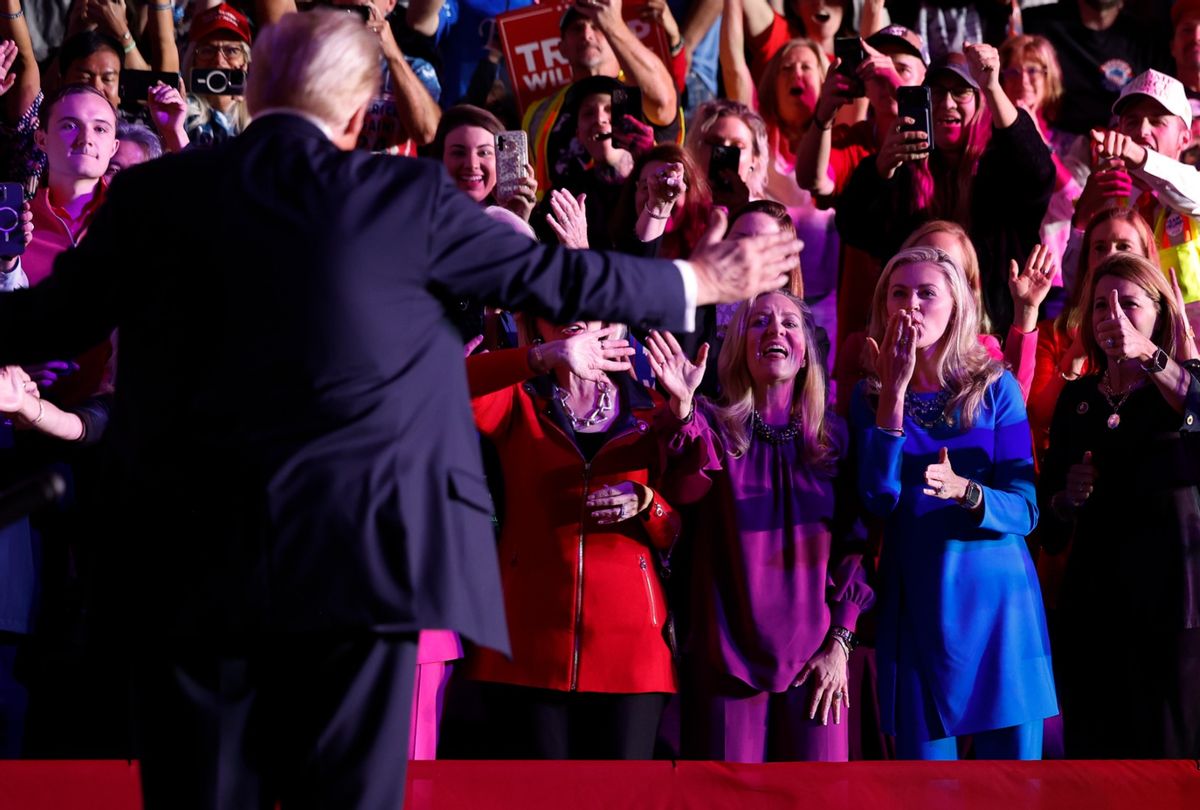Donald Trump would have his supporters believe that he could win California, along with the 49 other states, if election officials only counted votes the way he wanted (in 2020 as now, that means tossing out ballots for his opponent). At the end of his third run for the White House, however, the former president was busy not expanding the electoral map but trying to hold on in a place once thought safely red.
“Look, if I don’t win this thing after all this talk, I’m in trouble — will you please go and vote,” the Republican growled to an audience Sunday in Greensboro, North Carolina, where polls show him in a statistical dead-heat with the Democratic nominee. “I mean, I came here, whatever the hell time it is, who the hell knows. I’ve given you the full board. You wouldn’t let me leave at half an hour. I could have run up here, done it, start screaming, ‘Make America Great Again’ for five or six times and then leave to the cheers of the crowd. I would have been home sleeping by now.”
By his next stop in the Tar Heel state, the 78-year-old appeared even more exhausted, turning in what local outlet NC Newsline described as a “disjointed” appeal for votes in the small city of Kinston. There, Trump forgot who was on the ballot, praising a hedge fund manager running for the U.S. Senate in Pennsylvania before appearing to realize his mistake.
“You have one of the best of all right here, David McCormick. You know, that …. David is here someplace. You know, we just left him. He’s a great guy,” Trump said. In an indication of how he’s feeling about the race, perhaps, the Republican then moved on to praising Mike Lindell, the businessman and conspiracy theorist who claims Democrats only win through fraud.
Trump has good reason to be unsettled. Over the weekend, the Des Moines Register published a survey finding that Vice President Kamala Harris now leads Trump by three percentage points in Iowa, “a ruby-red state he has won twice.” That lead, in a state last won by Democrats in 2012, is driven by Harris 28% advantage with independent women and 35% margin with all women over 65.
“There’s obviously something going on here,” pollster J. Ann Selzer, a legend in her field, explained to the BBC. “Older people is who you want to appeal to because they are the most reliable voters. And Kamala Harris is doing very well with that group.”
One thing that is going on is that women in Iowa, in 2024, have fewer rights than they did in 2020. In July, the state imposed a near-total ban on abortion; November’s general election is the first chance voters will have to respond — and, perhaps, punish the man who boasts that it was his right-wing justices who tipped the scales and overturned Roe v. Wade two years ago.
Ultimately, Iowa may not turn blue; other polls suggest Trump may well be on track to a comfortable victory in a state neither candidate has bothered to campaign in. But other polls are not the Selzer poll: The New York Times’ Nate Cohn recently conceded that most pollsters are desperate not to underestimate Trump a third time and are fiddling with their numbers in potentially problematic ways to avoid that humiliation. Selzer, by contrast, basically got it right: In 2020, her final survey had Trump up by seven points (he ultimately won by 8, compared to an average lead in the polls of 1.3%) and seven points in 2016 (he won by 9, compared to an average lead of 2.9%).
We need your help to stay independent
One poll does not an election make, nor is a blue Iowa anything like a sure thing. But Trump, who has never won the popular vote, cannot afford to bleed support if he wants a repeat of his 2016 shock win — and Iowa even being a little less red could portend disaster elsewhere, with the latest New York Times/Siena College poll showing late-deciding voters breaking for Harris by double digits. Georgia, recall, was decided by 0.23% in 2020, or fewer than 12,000 votes.
Nate Silver, the professional gambler and election forecaster who has been bullish for Trump this cycle, said Harris supporters were right to be “rejoicing” over Selzer’s polling. The vice president, he noted, was appearing to surge at just the right time, resulting in “the race being truly a toss-up.”
“If Trump had ‘momentum’ in October, it has now petered out in November,” Silver wrote.
Momentum, like the polling industry, may well be fake. But the Trump campaign is certainly not acting like one that is confident of victory. Indeed, the candidate has returned to his 2020 playbook, crying fraud and accusing Democrats of “cheating” before most votes have been cast, much less counted. In Pennsylvania — the state where David McCormick is actually running — Trump falsely claimed that authorities had already found hundreds of fraudulent, filled-out ballots (in reality, they had flagged suspicious voter registrations).
If election night does not go the way Trump likes, it is all but guaranteed that he’ll declare victory anyway. Millions of people will believe him. He won’t have the presidency or control of the military, as he did in 2020, but he will have the power of Truth Social, Fox News and X.
“You can imagine the shock that some Trump supporters might feel if it turns out that he loses,” David Becker, head of the nonprofit Center for Election Innovation and Research, told The Washington Post, “and how that shock could be leveraged into anger and even potentially violence in the post-election period.”
The election will be on Tuesday, then, but the true test of America’s democracy will likely come in the days that follow.
Read more
about the 2024 campaign



Shares